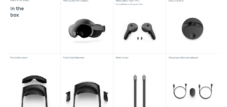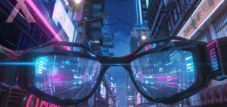Published on: June 5, 2025 / update from: June 5, 2025 - Author: Konrad Wolfenstein

“Loma” headset-Meta's strategic realignment: Development of a premium-VR glasses for immersive media consumption-creative image: xpert.digital
Loma: Metas vision of an ultra-light premium-VR glasses for 2026
Meta and the future of entertainment: an exciting VR glasses comes
Meta Platforms is working intensively on the development of a new, ultra-light premium-VR glasses, which is specially designed for media consumption and immersive videos and is expected to come onto the market in 2026. This device, coded as “Loma”, represents a fundamental change in Meta's VR strategy and aims to conquer the growing market for immersive entertainment. The company pursues a two-track approach: technological innovation through a revolutionary form factor and strategic partnerships with Hollywood studios to secure exclusive premium content.
Suitable for:
- The End of a Vision: Meta's decision to discontinue the Quest Pro and what that means for the future of VR
Technical innovation and design revolution
Revolutionary form factor and weight reduction
The “Loma” headset marks a decisive turning point in VR technology due to its radically changed form factor. While current VR headsets such as the Meta Quest 3 with 515 grams are still clearly recognizable as technical devices, Meta with Loma strives for a glasses-like appearance that differs significantly from the “massive headsets such as Meta Quest and Apple Vision Pro”. This design philosophy reflects Meta's realization that the current form factor is the greatest obstacle to the mass market acceptance.
The company solves the weight problem through an innovative outsourcing of the computing unit and battery into a wired external device that can be worn in your pocket. This solution is based on the model of the Apple Vision Pro, which also uses an external battery element, but goes one step further in miniaturization. The strategy follows the successful approaches of Magic Leap and Apple, which have already implemented similarly shared architectures.
Advanced display and control technology
Technically, the Loma headset relies on a significantly improved display technology that is “more powerful than the current Meta Quest” and offers “better video quality”. These improvements are essential for the desired focus on media consumption, since high -quality visual representation for immersive video content is of crucial importance. The device is expected to be equipped with modern pancake lenses and PASSHROUGH technology, similar to the quest 3.
Another technological progress is in the control method. As with the Apple Vision Pro, the Loma headset is “primarily operated by eye and hand tracking instead of controllers”. This contactless control underlines the focus on a natural, intuitive user experience, which is particularly suitable for media consumption, where traditional controllers could be perceived as annoying.
Strategic market positioning and pricing
Target group -oriented pricing policy
With the LOMA headset, Meta pursues a deliberately aggressive price strategy that positions the device between the two extremes of the VR market. With a desired sales price of “less than $ 1,000”, it is well above the “$ 300 entry price for a quest”, but “considerably cheaper than an Apple Vision Pro” with its price of $ 3,500. This positioning aims to open up a new market niche for premium-VR experiences without reaching the price limits of the Apple Vision Pro.
The price strategy reflects Meta's understanding of market dynamics, according to which there is a significant need for a mid-range premium device. This positioning could enable META to address both price-conscious customers who want more than the basic quest as well as to win interested parties that are deterred by the Pro vision.
Competitive challenge for Apple
The LOMA project can be interpreted as a “direct attack on Apple”, especially since “Immersive media consumption was identified as one of the most convincing application scenarios of the Apple Vision Pro”. Meta's strategy aims to create a device that could “be much easier and more compact than the Vision Pro”, while at the same time it offers a significant price advantage.
This positioning is particularly strategic, since Meta directly addresses the weaknesses of the Apple Vision Pro - its weight, size and high price. At the same time, Meta can fall back on its established VR experience and its developed ecosystem in order to achieve a technological lead.
Content strategy and Hollywood partnerships
Strategic alliances with premium content producers
Meta follows an aggressive content acquisition strategy to support the Loma headset with exclusive, high-quality content. The company "has approached Disney, the film studio A24 and smaller production companies to develop immersive content for the new VR glasses". These partnerships aim to produce both episodic and independent immersive video content based on “known brands”.
The financial dimension of this strategy is considerable: META “offers millions for immersive video formats” and at the same time negotiates “about the licensing of existing series and films”. These investments show META's willingness to invest considerable resources in content development in order to strengthen the hardware ecosystem and to bind users in the long term.
Suitable for:
- Jump into mixed reality: Will Meta & Lightstorm unleash the immersive entertainment with live sports, concerts and cinema of the future?
Established and future content cooperations
Meta has already won a “well -known partner for immersive content”: “At the end of 2024, the company announced a cooperation with James Cameron's production company Lightstorm Vision”. This partnership with one of the world's leading film producers for visual effects underlines META's ambitions to establish premium content for VR platforms.
The content strategy includes the development of completely new VR-specific content and the adaptation of existing intellectual property rights for immersive formats. Meta plans to offer “this content exclusively for VR devices for a certain period of time” before they are available in conventional 2D versions on other streaming platforms.
Market dynamics and industrial challenges
Current market problems and strategic realignment
The time for Meta's new VR strategy is particularly relevant in view of the current market dynamics. The company is fighting with “declining sales figures for the Meta Quest”, with “fewer devices sold in the first quarter of 2025” than in the previous year, “although the inexpensive Meta Quest 3S model was only launched for Christmas business”.
Despite the introduction of a cheaper model, META signals this sales weakness that a fundamental change in strategy is required. The development of the Loma headset represents Meta's response to this challenge-instead of another “marginal improved iteration of the meta quest”, the company develops a completely new product concept.
Internal data and usage behavior
Meta's strategic focus on media consumption is based on “internal data”, which show that “a growing quest user group understands the VR glasses as an expansion of their television and primarily uses for media consumption”. The company “expects this user group to play a major role in the Meta Quest ecosystem by 2027.
This data analysis underlines the foresight of META's strategic realignment. Instead of still relying primarily on gaming and general VR applications, the company recognizes the growing need for specialized media consumption devices and positions itself in the market.
Technological development landscape
Parallel development projects and product strategy
The LOMA project is part of a more comprehensive product strategy that includes several VR and AR devices developed in parallel. In addition to Loma, Meta works on the “Hyprenova” AR glasses for 2026, but with a “thick frame” and 70 grams of weight is less suitable for mass market. In addition, the ultra-compact “Puffin” project for 2027 is planned, which should “weigh less than 110 grams” and will have the “form factor of a chunky glasses”.
This diversified development strategy shows Meta's understanding that different areas of application require different technological approaches. While Loma is optimized for media consumption, Puffin addresses general portability, and Hypernova aims at AR applications.
Cost pressure and operational efficiency
The ambitious development plans are in the context of considerable financial burdens for Meta's Reality Labs Division. The company has invested $ 55 billion in reality Labs since 2019, but earned little with facial computers ". In response to this, “Zuckerberg initiates austerity measures” and the Reality Labs Division “must reduce the costs by 20 percent by 2026”.
These cost reduction initiatives could affect the development speed and the range of functions of future devices. At the same time, they demonstrate META's willingness to improve operational efficiency, while the company continues to invest considerably in VR/AR technologies.
Loma headset: Metas Gamechanger in the premium-VR area?
Meta's development of the Loma headset is a strategically significant turning point in the VR industry. Meta is positioned as a serious challenger for the Apple Vision Pro in the premium-VR segment through the combination of innovative hardware technology, aggressive pricing and strategic content partnerships. Focusing on media consumption as a primary area of application reflects a data-driven market analysis and could lay the foundation for a new product category that is located between gaming-focused VR headsets and all-purpose-ar-glasses. The success of this project will significantly depend on whether META can manage the technical challenges of miniaturization and at the same time build up a convincing content ecosystem that motivates consumers to adopt a new device category.
Suitable for:
Your global marketing and business development partner
☑️ Our business language is English or German
☑️ NEW: Correspondence in your national language!
I would be happy to serve you and my team as a personal advisor.
You can contact me by filling out the contact form or simply call me on +49 89 89 674 804 (Munich) . My email address is: wolfenstein ∂ xpert.digital
I'm looking forward to our joint project.













